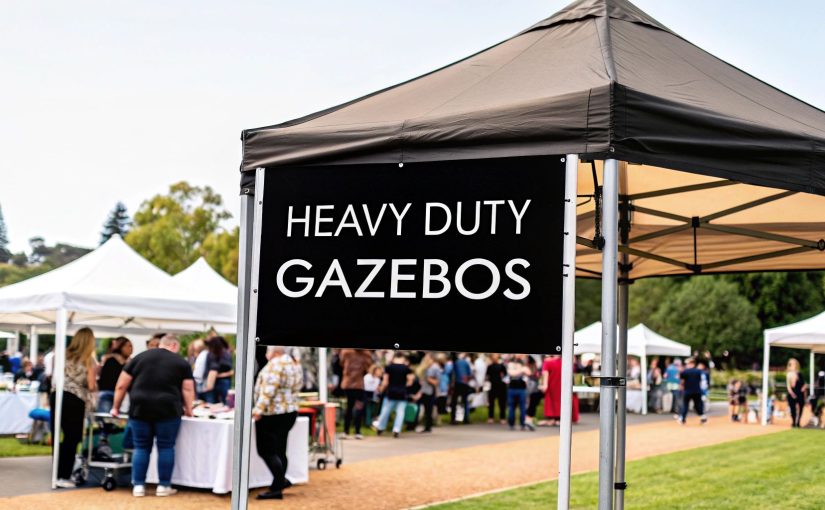When you’re planning an outdoor event, a heavy duty gazebo isn’t just a nice-to-have—it’s your first line of defence against the elements. Think of it less as a simple shelter and more as a core piece of your event setup, built with a tough frame and quality fabrics designed to handle South Africa’s famously unpredictable weather, from blazing sun to a sudden downpour.
Why a Heavy Duty Gazebo Is a Smart Investment
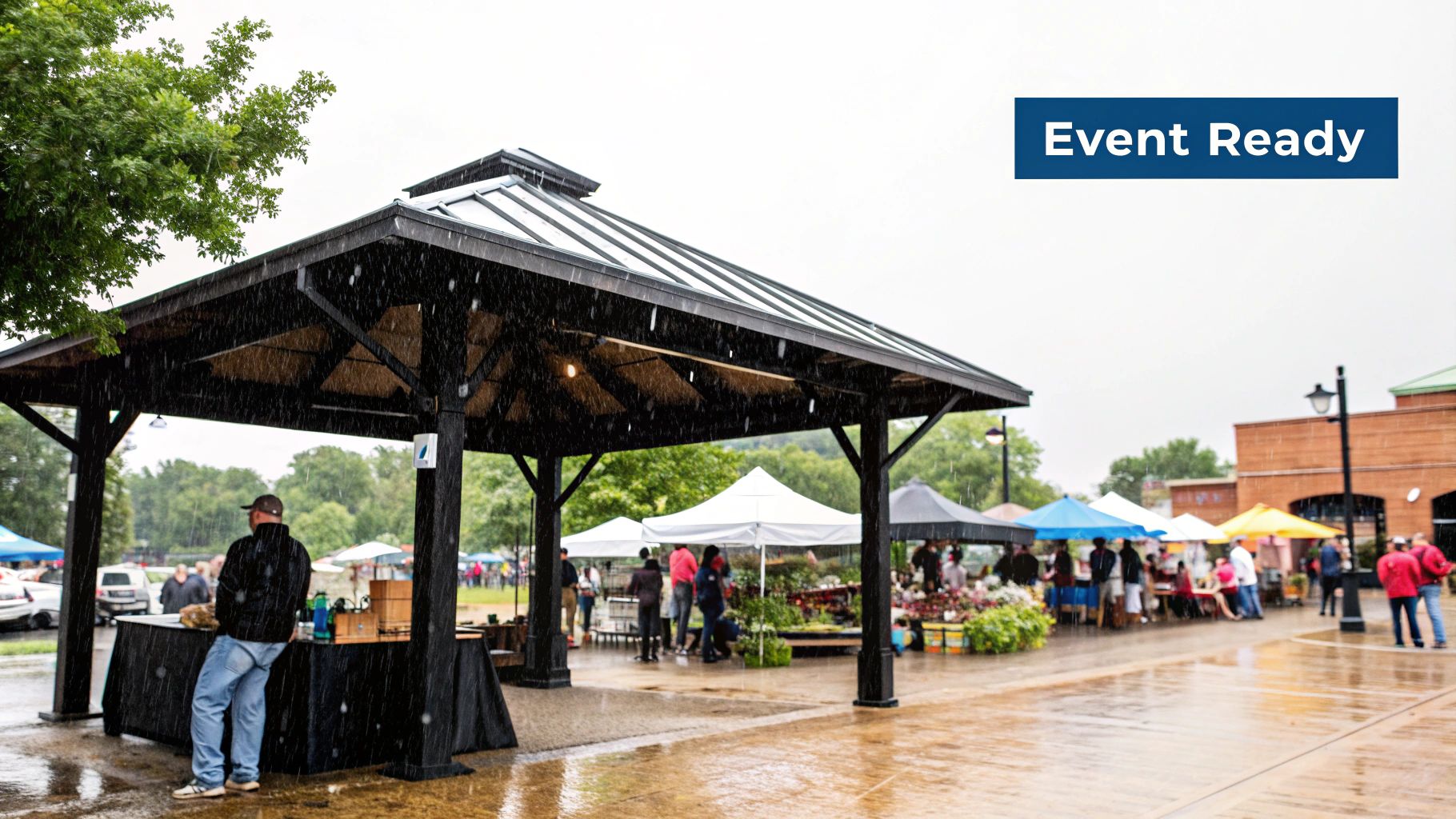
Anyone who’s organised an event outdoors in South Africa knows you have to be ready for anything. One minute it’s beautiful sunshine, the next a Highveld thunderstorm or a fierce Cape wind is rolling in. This is exactly when a standard, flimsy gazebo from a hardware store will let you down, putting your guests, your products, and your entire event at risk.
A heavy duty gazebo, on the other hand, is built for exactly these challenges. It’s not just about providing a bit of shade. It’s about creating a secure, professional, and genuinely comfortable space, whatever the weather decides to do. It becomes the reliable heart of your event, giving you the peace of mind to focus on your guests instead of constantly checking the weather forecast.
The Core Benefits of Choosing Strength
Going for a heavy duty model gives you some serious advantages that can make or break any gathering, whether it’s a corporate launch, a market stall, or a private party. These benefits directly influence the success of your event and how much your guests enjoy themselves.
Here’s what you really gain:
- Superior Durability: They’re built to last, with thicker steel or aluminium frames and high-denier, properly waterproof fabrics.
- Enhanced Safety and Stability: With a solid construction and the right anchoring, they stay put in wind and rain, keeping everyone safe.
- Professional Appearance: A sturdy, clean gazebo just looks better. It projects an image of quality and reliability, which reflects well on your brand or event.
- Versatile Application: From food stalls and product displays to wedding receptions and registration points, their resilience makes them the right choice for almost any outdoor scenario.
Think of a heavy duty gazebo as your event’s anchor. It gives you a dependable, all-weather hub that ensures things run smoothly, protecting both your investment and your reputation.
Meeting the Demands of South African Events
More and more, we’re taking our lives and our events outdoors. This is especially true for South Africa’s busy tourism and hospitality scenes, where hotels and venues are constantly hosting functions in their beautiful outdoor spaces. This shift means there’s a real need for functional, long-lasting gear, and heavy duty gazebos are the perfect solution for reliable, reusable, and professional shelter.
Getting these details right is what separates a good event from a great one. A detailed event planning checklist template is a massive help in making sure you’ve covered all your bases. A dependable gazebo is one of those foundational items on the list that supports the whole event, making sure you’re ready for whatever the day throws at you.
Understanding Gazebo Materials and Build Quality
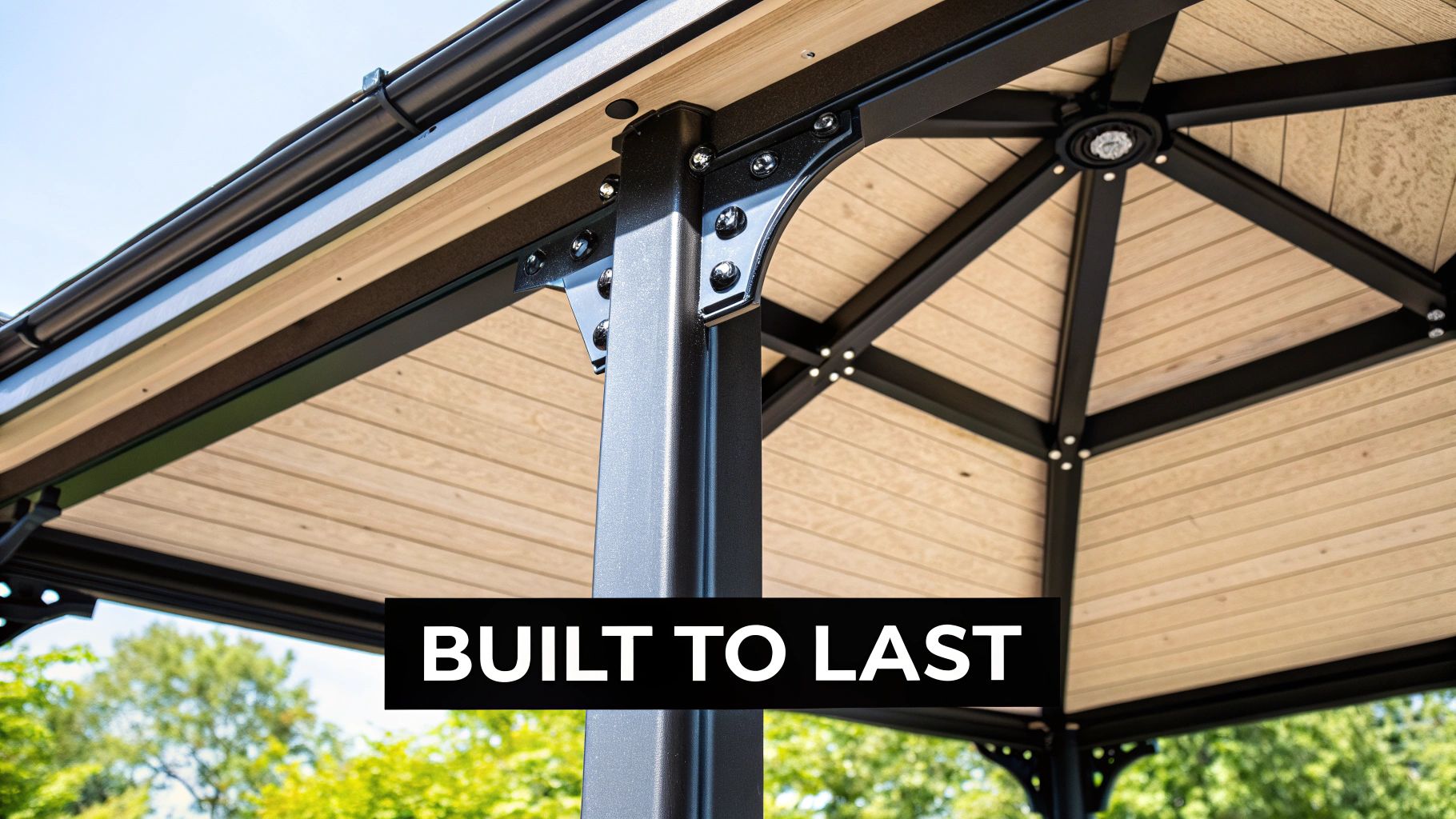
So, what really makes a gazebo ‘heavy duty’? It’s not just about how it looks. You’ve got to get up close and personal with its core components. Think of it like a building: its strength comes from its foundation—the frame—and its ability to protect what’s inside—the canopy. Getting to know these materials is the secret to picking a structure you can count on.
A top-tier heavy duty gazebo is a well-oiled machine where every single part plays its role. From the metal in the legs to the stitching on the roof, it all adds up to create a strong, long-lasting shelter. When you know what to look for, you can spot real quality and make a choice with confidence, whether you’re buying or hiring.
The Frame: The Skeleton of Your Shelter
The frame is the absolute backbone of any gazebo. It’s what gives it the guts to stand firm against a blustery Cape Town wind and hold up the weight of the canopy. The type of metal used is the biggest decision here, with each offering a different mix of strength, weight, and rust resistance.
For high-quality frames, two materials really lead the pack:
- Powder-Coated Steel: This is the heavyweight champion. Steel is incredibly strong and rigid, making it the go-to for larger heavy duty gazebos that have to endure serious stress. That powder coating isn’t just for looks; it’s a crucial protective layer that fights off rust and scratches. This is a must-have for gear used often outdoors, especially in the humid or coastal parts of South Africa.
- Anodised Aluminium: If steel is the heavyweight, then aluminium is the nimble, agile fighter. It’s much lighter, which makes a world of difference when you’re transporting and setting it up. A huge bonus for market vendors or mobile event teams. The anodising process hardens the surface, giving it fantastic protection against corrosion while keeping the frame light and easy to handle.
But don’t just stop at the metal type. Take a look at the thickness of the legs and the crossbars. A properly robust frame will often have hexagonal or square-profile legs, as these shapes are far better at resisting bending and buckling than your standard round poles.
The Canopy: Your First Line of Defence
The canopy is your main shield against sun and rain, and its quality is every bit as important as the frame’s. The fabric’s toughness and weather resistance all come down to its material, thickness, and any special coatings it might have.
When you’re checking out canopy specs, you’ll come across a few key terms. The most common one is the Denier (D) rating, which simply tells you how thick the fabric fibres are. A higher denier number means a thicker, stronger, and more durable material. For a reliable event shelter, you should be looking for a canopy made from at least 500D to 600D polyester.
Polyester is the popular choice because it’s strong, doesn’t stretch or shrink much, and holds its colour well. But the fabric itself isn’t the whole story.
The secret to a truly weatherproof canopy lies in its coating. A high-denier fabric without a waterproof coating is like a raincoat that isn’t seam-sealed—it will eventually let water through.
This is where coatings like PVC (polyvinyl chloride) or PU (polyurethane) come in. They are applied to the underside of the fabric, creating a barrier that water just can’t get through. For any gazebo that needs to keep people and gear dry during a surprise downpour, a PVC or PU coating is non-negotiable. It also adds a vital layer of UV protection, shielding guests from harsh rays and stopping the canopy from degrading in the strong South African sun.
The Details That Signal True Quality
While the frame and canopy are the stars of the show, it’s the small, often-overlooked details that separate a truly premium heavy duty gazebo from an average one. These little things are the tell-tale signs of smart engineering and solid construction.
Keep a sharp eye out for these critical elements:
- Reinforced Seams and Stress Points: Check the stitching on the canopy. High-quality models will have double-stitched or heat-sealed seams to stop water from sneaking in. Key stress points, like the corners and the peak, should have extra layers of fabric to prevent them from tearing under tension.
- Robust Connectors and Joints: The joints where the frame poles connect can be weak spots. On the best gazebos, these are made from high-density nylon or cast aluminium, not brittle plastic. These tougher connectors make sure the frame glides smoothly during setup and stays rigid when it’s up.
- Reliable Anchoring Systems: A gazebo is only as secure as its anchors. A quality kit will come with heavy-duty pegs for grass and strong guy ropes to brace it against the wind. The anchor points on the frame and canopy should be securely attached—look for metal D-rings or reinforced fabric loops that won’t rip off under pressure.
Choosing the Right Gazebo Size for Your Event
Picking the right size for your heavy duty gazebo is easily one of the most critical decisions you’ll make. It’s a bit of a balancing act. If you go too small, your guests or customers will feel like they’re packed in a tin of sardines. Go too large, and the space feels cavernous and empty, killing the atmosphere and wasting precious venue space.
The good news? You don’t have to guess. There’s a simple rule of thumb that gives you a fantastic starting point. From there, you just need to tweak it based on what you’ve got planned for your event.
Start With a Simple Space Calculation
For any event where people will mostly be standing and mingling—think a cocktail party or a market stall—allow about one square metre per person. It’s a beautifully simple formula that works. This gives everyone enough elbow room to move around comfortably without constantly apologising for bumping into someone.
So, a standard 3×3 metre heavy duty gazebo gives you nine square metres of cover, which is perfect for about nine people standing. A bigger 3×6 metre model offers 18 square metres, comfortably fitting around 18 people.
This handy infographic breaks down how to estimate your capacity using this simple rule.
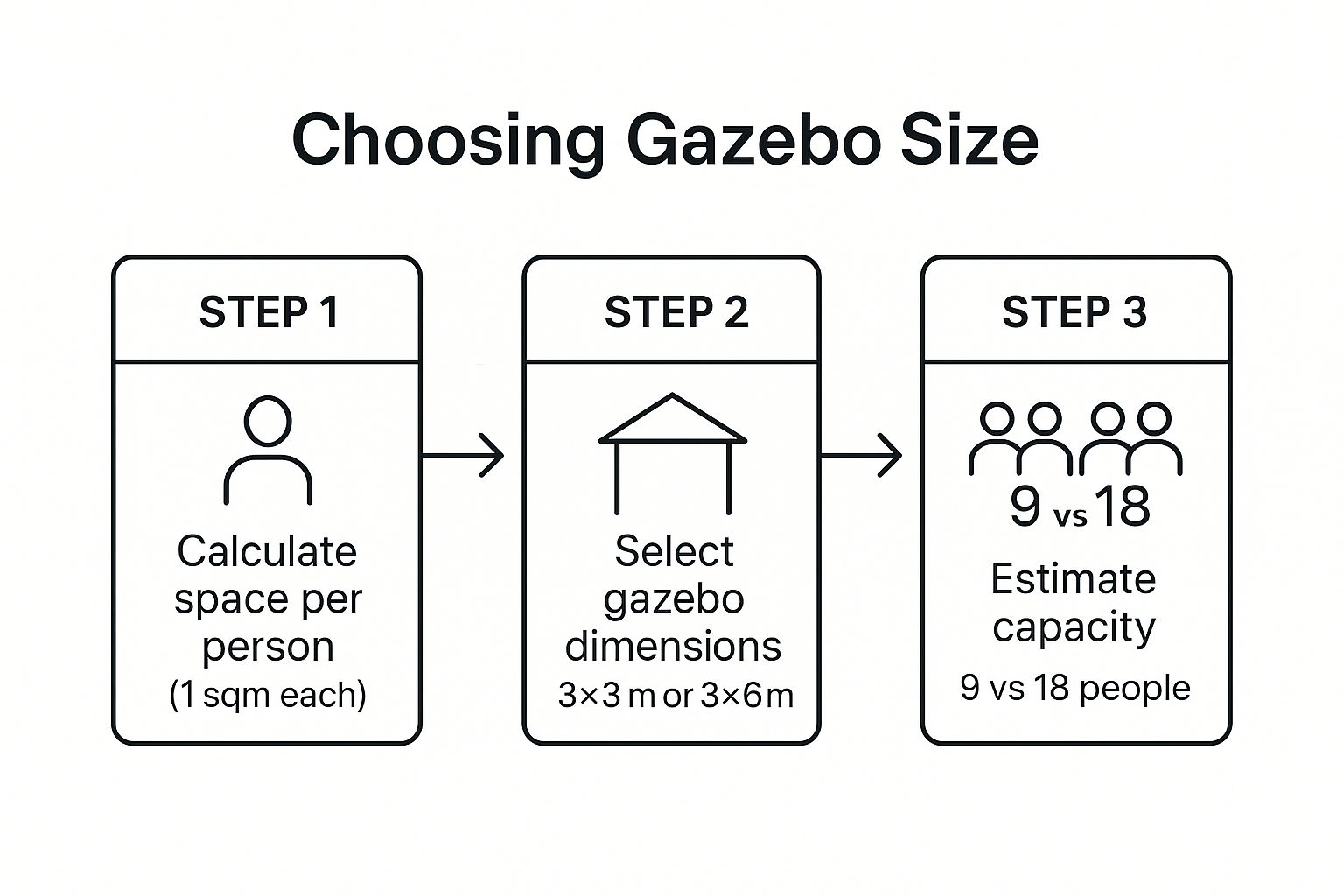
As you can see, it doesn’t take much to go from a rough headcount to a practical gazebo size, ensuring you avoid any awkward overcrowding on the day.
Planning Layouts for Different Functions
Of course, life isn’t always a stand-up cocktail party. The moment you start adding tables, chairs, display units, or any kind of equipment, the maths changes completely. You have to start thinking less about pure numbers and more about the actual flow and layout of your setup.
Let’s look at a few common scenarios:
- The Bustling Market Stall: In a 3x3m gazebo, you could have your main display table at the back. This leaves just enough room for one or two staff members and a couple of customers to browse without causing a traffic jam.
- A Seated Wedding Reception: This is where you need to think bigger. A single round table for eight guests can chew up most of the space in a 3x3m gazebo. If you’re planning for multiple tables, you’ll definitely need a 3x6m or even a few gazebos linked together.
- Corporate Registration Desk: Here, smooth flow is everything. A 3x6m gazebo is ideal. You can set up a long registration table down one side, leaving a clear, sheltered channel for attendees to queue up on the other.
The shape of the gazebo matters, too. Rectangular models are the most popular because they’re so versatile for creating defined spaces. But a hexagonal or octagonal heavy duty gazebo can create a fantastic central hub, perfect for an info booth or a social focal point.
Gazebo Size Guide and Capacity
To make things even clearer, here’s a quick-reference table to help you match a gazebo size to your event’s needs.
| Gazebo Size (Metres) | Standing Capacity (Approx.) | Seated at Tables (Approx.) | Ideal For |
|---|---|---|---|
| 3m x 3m | 9 people | 6-8 people | Market stalls, info booths, small food vendors |
| 3m x 4.5m | 13 people | 10-12 people | Registration areas, small catering stations |
| 3m x 6m | 18 people | 16-18 people | Small receptions, retail displays, first aid tents |
| 4m x 8m | 32 people | 25-30 people | Medium-sized parties, buffet lines, corporate lounges |
| 6m x 6m | 36 people | 30-34 people | Wedding ceremonies, art exhibits, central hubs |
This table gives you a solid estimate, but always remember to factor in extra space for walkways, decor, and any special equipment you might have.
Real-World Examples: 3x3m vs 3x6m
Let’s really picture the difference between the two most common sizes. The 3x3m is the absolute workhorse of the events industry. It’s compact, a breeze to set up, and incredibly versatile. It’s your go-to for a single-purpose station like a ticket booth, a product sampling stand, or a small food stall.
The 3x6m, on the other hand, just gives you more room to play with. That extra space unlocks more complex layouts. You could have a retail display at one end and a payment counter at the other, or even create a small lounge area with a few chairs for guests to take a break. If you’re weighing up your options, our guide on gazebo for hire has more great insights on matching the right structure to your event’s scale.
Getting Your Gazebo Set Up Safely
A heavy duty gazebo is a fantastic piece of kit, but it’s only as strong as its setup. Getting it assembled and secured properly isn’t just a good idea—it’s absolutely essential. An unsecured gazebo can turn into a massive, dangerous kite in a strong gust of wind, putting people and property at serious risk.
Think of this as your field guide to a rock-solid, stable setup. We’ll walk through everything from picking the right spot to mastering the art of anchoring, making sure your shelter stays put, no matter what.
Step 1: Start with Smart Site Selection
Before you even think about unfolding that frame, take a good look around. The ground you choose is the foundation for your gazebo’s stability, so this first step is crucial.
You’re looking for the flattest, most level patch of ground you can find. Setting up on a slope is asking for trouble; it makes the whole structure wobbly and puts weird stress on the frame, which can cause damage over time. Give the area a quick sweep for any sharp objects—rocks, sticks, or bits of glass—that could rip the canopy or sidewalls.
Don’t forget to look up! Avoid setting up right under big tree branches that could come down in a storm or, even worse, under power lines. A nice, clear, open space is always your best bet.
Step 2: The Assembly Process
Okay, site selected. Now it’s time to get the gazebo up. Most heavy duty pop-up gazebos are designed to be put up quickly, but you’ll want at least two people to make the job easier and a whole lot safer.
- Extend the Frame: Place the folded frame in the middle of your spot. With one person on each corner, gently pull the frame outwards until it’s about three-quarters of the way open.
- Attach the Canopy: Now, while the frame is still low, throw the canopy over the top. Line it up and secure the corners with the Velcro tabs. Trust me, doing this now is way easier than when the frame is at its full height.
- Final Extension and Locking the Legs: Keep pulling the frame outwards until you hear it click into place. Now, extend the telescopic legs one by one—if it’s breezy, start on the side the wind is coming from. Listen for that satisfying click from the locking pin on each leg to know it’s secure.
A classic mistake is trying to attach the canopy after the frame is fully extended. You end up stretching and fighting with it, which is a great way to tear the fabric or damage the frame. Always get the canopy on while the frame is still low.
Step 3: Master the Art of Anchoring
This is it. The single most important step for keeping your heavy duty gazebo safe. Never, ever leave a gazebo freestanding without proper anchoring. How you do it will depend entirely on the ground you’re on.
Different surfaces need different approaches. Here’s the breakdown for typical South African spots:
- On Grass or Soil: This is perfect. You’ll want to use heavy-duty steel pegs and hammer them into the ground at a 45-degree angle, pointing away from the gazebo. Then, run guy ropes from the canopy corners down to the pegs to brace it against the wind.
- On Paving or Concrete: Pegs are out, so leg weights are your best friend. Use proper sandbags or water weights that wrap tightly around each leg. You should be aiming for a solid 15-20 kilograms per leg for real stability.
- On Beach Sand: Your normal pegs won’t do a thing here. You need special sand pegs, which are much longer and wider to get a grip. Another great trick is to fill buckets with sand and use them as anchor points for your guy ropes.
For total peace of mind, especially if the wind picks up, combine methods. Even on grass, adding weights to the legs gives you that extra bit of security, keeping the frame grounded before the guy ropes even get a chance to tighten.
Best Practices for Takedown and Storage
Putting the gazebo away properly is just as important as setting it up. A little care during disassembly will add years to its life, protecting your investment for many more events.
The golden rule? Make sure the canopy is completely clean and dry before you pack it away. Folding up a damp canopy is a one-way ticket to mould and mildew, which will wreck the fabric and its waterproof coating.
Take the frame down in the reverse order of assembly. Release the leg locks, lower it, and gently push it inwards. Pop it back in its protective bag and store it somewhere cool and dry, out of direct sunlight that can fade and weaken the fabric over time. A few extra minutes here saves you a lot of headaches later.
How to Customise Your Gazebo for Any Occasion
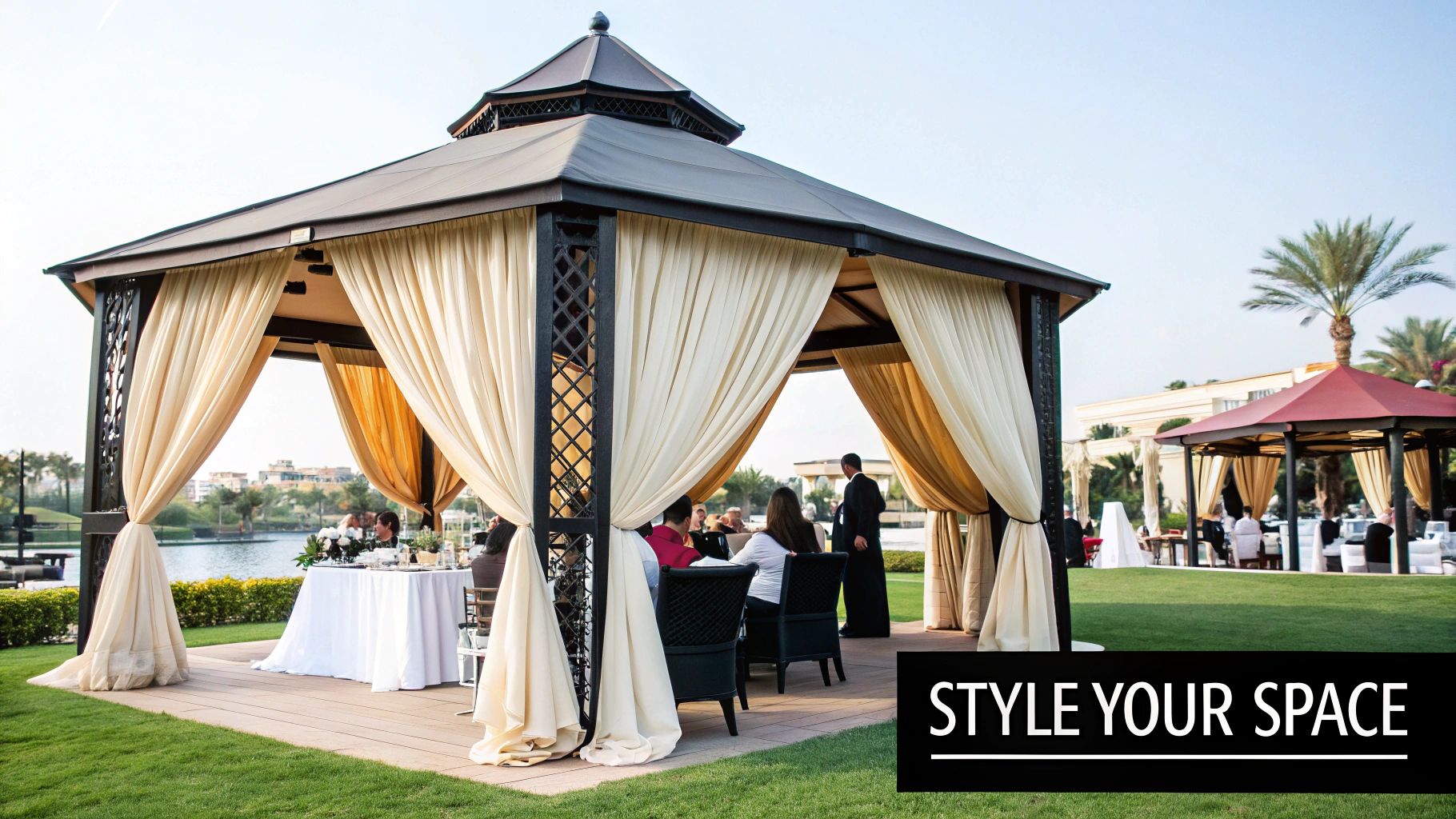
A heavy duty gazebo is far more than just a roof over your head; think of it as a blank canvas, ready to be transformed. With a few custom touches, you can take it from a simple structure to the absolute centrepiece of your event. Whether you’re looking to boost your brand or create a magical atmosphere, customisation is where the magic happens.
And the best part? This transformation doesn’t need to be complicated or break the bank. Even simple additions can completely change the look and feel, making the space more inviting, professional, and memorable for everyone.
Branding for Business Events
For any business, a heavy duty gazebo is a powerful marketing tool. At a trade show, a local market, or a corporate function, your gazebo is often the very first impression you make on potential clients. Making it instantly recognisable isn’t just a nice touch—it’s essential.
The most effective way to stand out is with custom printing. Your canopy and sidewalls are basically a three-dimensional billboard. You can add:
- Logos and Brand Colours: A canopy printed in your company’s signature colours with a big, bold logo ensures you’re seen from across a crowded venue.
- Contact Information: Pop your website or social media handles on the valances or sidewalls. It makes it dead simple for interested people to find you later.
- Promotional Messaging: Use the space to shout about a new product, a special offer, or your company tagline.
Suddenly, your shelter is an active part of your marketing strategy, creating a professional look that builds trust and pulls people in.
Styling for Personal Celebrations
When it comes to personal events like weddings, birthdays, or anniversaries, customisation is all about creating a vibe. Your gazebo sets the scene, and a few creative touches can make all the difference between a nice party and an unforgettable one.
Elegant drapery is a brilliant place to start. Swagging sheer white or ivory fabrics from the frame instantly softens the structure, creating a romantic, sophisticated feel that’s perfect for a wedding. It’s a simple trick that turns a standard gazebo into a beautiful ceremonial space.
Lighting is another game-changer, especially once the sun goes down.
Good lighting doesn’t just help people see; it sets the mood. It can make a space feel intimate, festive, or dramatic, guiding your guests’ experience from the moment the sun goes down.
Wrapping the frame with string lights or hanging a few lanterns from the roof casts a warm, magical glow. For a truly spectacular effect, you can get some great ideas from our guide on using a fairy light curtain to create a stunning backdrop.
Practical Enhancements for Comfort and Flow
Beyond just looking good, customisation can also make your space work better, keeping guests comfortable and making sure the event runs smoothly.
- Flooring: Laying down temporary flooring, like interlocking plastic tiles or even a stylish outdoor rug, makes the space feel more defined and is much nicer to walk on. It also saves your guests’ shoes from mud or damp grass.
- Furniture Layout: Think carefully about where you place furniture to encourage conversation and manage the flow of people. For a party, you could create small, cosy seating areas. For a market stall, make sure there’s a clear path for customers to browse.
- Climate Control: For those hot South African days, hiring portable fans or misters is a lifesaver. When it gets cooler, outdoor heaters positioned just outside the gazebo will keep the space warm and inviting.
These practical touches show a level of thought and care that your guests will really notice, helping make your event a massive success.
Your Heavy Duty Gazebo Questions Answered
When you’re looking to invest in a quality shelter for your events, a few key questions always pop up. Getting the right answers helps you pick the best option and look after it properly, making sure it serves you well for years to come. Here, we tackle the most common queries we get about using heavy duty gazebos in South Africa.
We’ve pulled together our insights on everything from cleaning and wind resistance to whether you should buy or hire. Think of this as your quick-reference guide for practical, no-fuss advice.
How Do I Clean My Heavy Duty Gazebo Canopy?
Keeping your gazebo canopy clean isn’t just about looking professional; it actually helps it last longer by stopping dirt and grime from breaking down the fabric. A little bit of regular care goes a very long way.
For everyday dust and dirt, the best method is the simplest. First, use a soft brush to gently sweep off any loose debris. Then, mix up some mild soap (like regular dish soap) in lukewarm water and gently wash the fabric. It’s absolutely vital that you avoid harsh chemical detergents or bleach. These will strip away the canopy’s essential waterproof and UV-protective coatings, leaving it vulnerable.
For tougher stains like bird droppings or tree sap, it’s best to act fast. You can find specialised fabric cleaners made for outdoor gear. Just be sure to test it on a small, hidden spot first to make sure it doesn’t affect the colour.
Here’s the most important rule for canopy care: always make sure the fabric is 100% dry before you fold it away. Packing it up while it’s even a little bit damp is a surefire way to get mould and mildew, which can permanently damage and stain the material.
What Wind Speed Can a Heavy Duty Gazebo Withstand?
This is a massive safety question, and the answer really boils down to two things: the quality of the gazebo itself and, most importantly, how well you’ve anchored it. A proper heavy duty gazebo is built to handle tough conditions, but it can’t do it alone.
A top-quality model that has been correctly secured can typically handle steady winds of around 25 to 40 km/h. But you only get that level of performance if you use all the anchoring gear properly. That means driving heavy-duty pegs deep into the ground at an angle, pulling the guy ropes taut to brace the corners, and using substantial leg weights to keep the base stable.
Here’s the golden rule for windy days:
- Never leave it unanchored: A gazebo must be secured, even if there’s only a light breeze.
- Use a combination of anchors: On grass, using both pegs and leg weights gives you the best possible hold.
- When in doubt, take it down: If strong winds or a big storm is on the way, the safest bet is always to pack the gazebo away. No temporary structure is invincible, and safety has to come first to prevent damage or injury.
Should I Buy or Hire a Heavy Duty Gazebo in South Africa?
The buy-or-hire debate really comes down to how often you’ll be using it. Both options have their perks, so the right choice is all about your specific needs.
Buying a heavy duty gazebo is a great long-term investment if you’re regularly hosting events. If you’re a market vendor, run a mobile business, or are in the events industry, owning your gear means you can brand it however you like and it works out cheaper over time. You have it on hand whenever you need it, no booking required.
On the other hand, hiring is the perfect solution for one-off events like a special birthday party, a wedding, or an annual company function. Hiring is much easier on the budget for a single use, and you don’t have to worry about cleaning, transport, or finding a place to store it. Plus, professional hire companies will handle the delivery, setup, and takedown for you, which saves a ton of time and effort.
Can I Add Sidewalls to My Gazebo Later?
Yes, absolutely! Most quality heavy duty gazebos are designed to be modular, so you can easily add accessories like sidewalls long after you’ve bought the frame. This flexibility is one of their biggest advantages.
Sidewalls are usually sold separately and are a breeze to attach, typically with heavy-duty Velcro straps, strong zips, or secure clips. They’re incredibly handy for giving you extra protection from wind-driven rain or low-angle sun, creating a bit more privacy, or completely enclosing the space for a cosier vibe.
For the best results, we always recommend buying sidewalls from the same brand as your gazebo. This guarantees they’ll fit perfectly, the colour will be a match, and the attachment systems will be compatible. Adding walls is a simple and effective way to make your shelter far more versatile.
At ABC Hire, we provide a wide selection of premium heavy duty gazebos and event furniture to make your occasion a success. Whether you need a sturdy shelter or stylish accessories for your event in Cape Town and surrounding areas, we have you covered. Explore our rental options at https://abchire.co.za and let us help you create an unforgettable experience.

